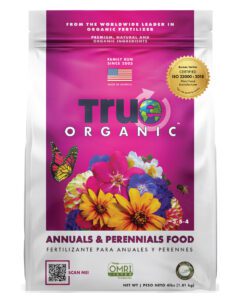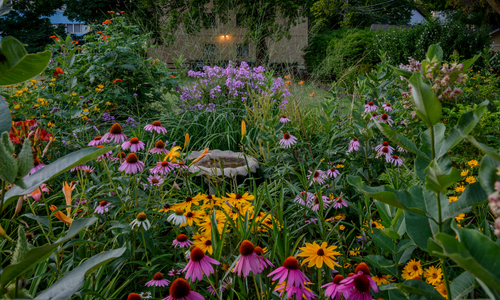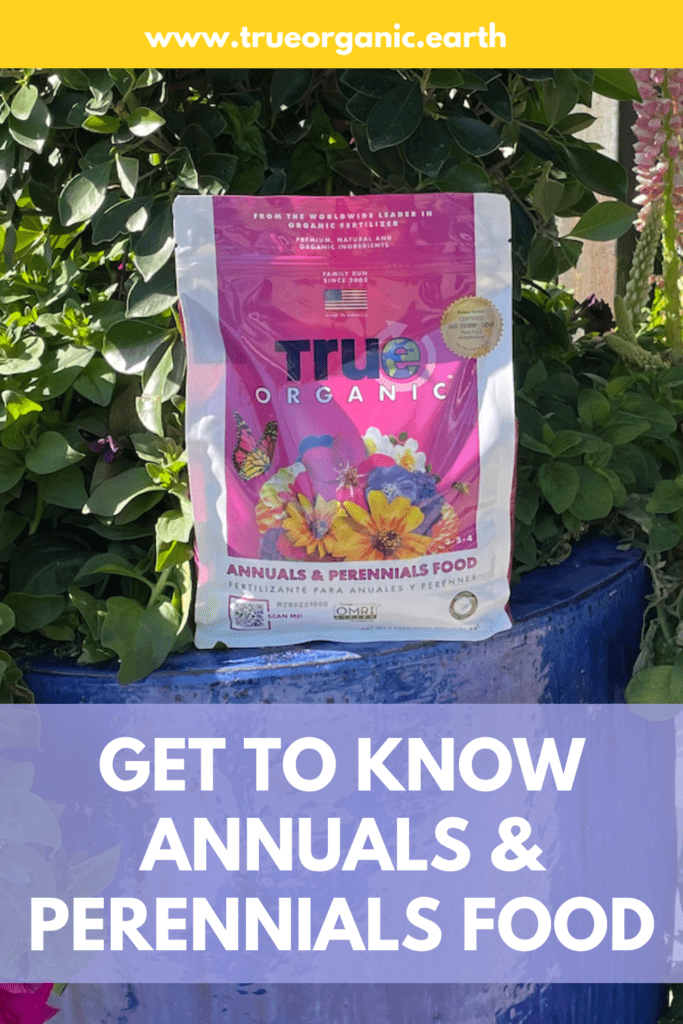February 27, 2023
Get to Know Annuals & Perennials Food
Meet the newest addition to the True Organic Plant Food lineup: our Organic Annuals & Perennials Food! We’re excited to answer some common questions about this new granular blend.

How is the Annuals & Perennials Food different from other True Organic plant foods?
This uniquely crafted blend is higher in phosphorus and potassium (relative to nitrogen). Phosphorus and potassium encourage flower growth (reproductive growth) over vegetative growth. A more generalized food like our All-Purpose Plant Food has more nitrogen to encourage more vegetative growth. But when you plant flowers, you want blooms! Specifically, you want to see more blooms than stems or greenery. Raising a sturdy plant is important for getting prolific, healthy blooms.
Phosphorus ensures that the energy taken in by the plant is moved into roots for development and growth, as well as for flowering.
The increased potassium is good for establishing strong shoots and roots at the cellular level, so that the plants can pull up lots of nutrients. This is especially important for perennials, since they are long-lasting garden additions that hold up lots of beautiful blooms (hopefully)! Potassium in the form of soluble potash can also contribute to increased size of blooms.
Let’s look at the premium ingredients used in this blend. What are they and how does each contribute to plant and soil health?
Shrimp Shell Meal and Crab Shell Meal: These both contain high proportions of chitin, a nitrogen-rich amino sugar that triggers an immune response in plants — so it helps suppress soil-borne diseases. Shells also contain calcium and magnesium. Calcium increases cell wall strength and helps reduce the likelihood of things like blossom end rot; magnesium is key to a plant’s ability to absorb sunlight because it’s an essential part of chlorophyll.
These two ingredients also tend to break down quicker than bone meal.
Poultry Manure: While many kinds of manure can make a great base for granular fertilizers, poultry manure is widely used in gardening and agriculture because it tends to be higher than other animal manures in the nutrients that plants most need. Of course, it’s also a good source of organic matter. Our poultry manure comes from organically fed birds and passes through the most rigorous food safety-certified protocol possible, so this organic goodness is ready to nourish plants and soil.
Soybean Meal: Typically high in nitrogen and low in phosphorus and potassium, this plant-based fertilizer component is slow-release. That means it can feed the plant over the growing season in small increments. It’s good to note that microorganisms will break this material down easiest during warm, wet weather (or when you consistently water during warm weather).
What home garden plants is Annual & Perennial Food best for?

Any plants that should NOT get any Annual & Perennial Food?
Annual & Perennial Food isn’t aimed at heavy nitrogen feeders (like tomatoes, corn, peppers, etc.). You can use Annual & Perennial Food as a timed application to help boost blooms or fruit in things like peppers and tomatoes, but it shouldn’t be your primary source of fertilizer.
Margaret’s top tips:
- Remember to keep the soil moist to help the fertilizer break down for plant uptake by soil microorganisms, but not so wet that roots begin to rot!
- Over-applying will not always get bigger or better results!
- If you grow the same plants in the same place every year, try to change it up so that you can replenish the nutrients removed by those plants.
- You can also amend the soil by adding compost or other organic material in the fall when you remove that season’s plants. This gives you a leg up when you plant the following season.
- Fertilizing perennials is different from what you might be used to with annuals. Take time to research your plants so you always have the best blooms on the block. Flower show winners! I mean, is it really gardening if you don’t brag about your crops?! (Not that we’re competitive over here or anything…)
Happy gardening!
Show us your True Organic Plants
#GrowWithTrue
www.trueorganic.earth



